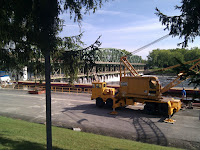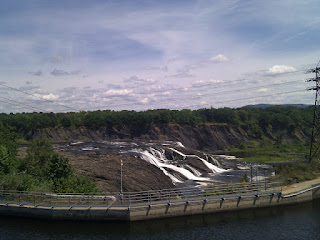This is the first in a three part series.
Part 1 talks about my take on how the courses were presented.
in Part 2, I'll discuss my take on how to improve the experience
and finally, in part 3, we'll look at on line education with an emphasis on the high school market.
As some of you know, I've been taking the on line
Machine Learning and
Artificial Intelligence courses offered by Stanford this semester. I took my AI class a hundred years ago and I never formally studied ML so I figured this would be a fun way to keep current.
Lots of people have already "reviewed" the courses, compared the instructors, assignments, and what have you. Now that the courses are almost over, I thought I'd try to look at it a little differently, wearing my hat as a high school CS educator rather than just a consumer.
I've enjoyed both courses tremendously and I'd like to thank everyone involved in making them available to the public.
Teaching style:Every teacher has their own style. Here's my take on our three instructors. I don't think any one style is universally better than any other, rather different styles speak to different students.
Peter Norvig: While watching Professor Norvig's videos, I felt that he was the learned sage imparting information. He's the wise man in the village that everyone turns to for answers.
Andrew Ng:I felt like I was with a tutor or a coach, everything was gently presented and at the end of the lecture I looked back and said "wow, I got all of that, it made sense." As he was the only lecturer for the ML class, I'll explain in more detail in the next section.
Sebastian Thrun:I can't come up with an analogy for Profressor Thrun, but I could feel him saying "let's try something neat, make some mistakes, explore neat things, and learn a whole bunch as a result." It took a while to get used to this, particularly when being asked questions before given enough information to approach them. Once used to the technique, however, I really enjoyed his approach to teaching.
Conclusions: I would love to have the opportunity to sit in on live classes with all three as sitting in on a class can be very different from watching a video, but being on the east coast, I don't think that will happen any time soon.
Lecture style:
In the ML lectures, Prof. Ng gently guided the viewer through the topics. Generally first by describing the various parts of the topic in question and then by bringing it all together, completely describing the algorithm or technique.
There are points in the lectures where Prof Ng states that the material is hard and that he had a tough time with some of it. This empathy and his assurances go a long way. I found the lectures easy to absorb and didn't generally have to think too hard. By itself this might have limited the educational experience, but combined with the assignments, it worked great.
The AI class had a different approach. The class was frequently tasked with solving problems before material was presented. This turned me off early on. As the class progressed, the professors started to emphasize the fact that your quiz scores didn't matter (they appear on the web site but aren't calculated in the final grade, not that the final grade matters anyway) and that these questions were to get you thinking about the topic more deeply. Once I started looking at the approach from this point of view, I enjoyed the class much more.
That said, I found the ML class lectures much more self contained and found myself looking for additional resources to learn the "base" material at times in the AI class.
The AI lectures forced me to think more than the ML class which is probably a good thing since there were no programming projects to take up the slack.
Conclusions: Styles differ but both can be effective. I could make as much or as little a mental effort as I wanted for the ML class and I'd get out of it what I put in. The AI required more effort to get anything out of it -- the approach forced you to think where the ML class encouraged you to think. In the end, I put comparable amounts of time into both and got about the same amount out of each.
Homework and Projects:
Both classes had weekly homework assignments. Without these, I would probably have slacked off on the videos.
In the AI class, these were submitted over the course of the week and then graded. Results and explanation videos were provided after grading was done. The process was fine but I found the interface occasionally frustrating. There were some complaints on the message boards about losing points due to mis-entry or insufficient accuracy of answers. I had a few problems with both but since I wasn't obsessed with getting a perfect score, it didn't bother me too much.
I'm not sure how great the assignments were in terms of assessments but attempting them and then watching the video explanations turned out to be a strong pedagogical approach. I would recommend including the explanation videos in the regular sequence for the in lecture quizzes. I frequently gleaned a tidbit or two from them even when I answered the questions correctly.
The only downside to the AI class quizzes and homeworks is that they were all in video form. A PDF of the midterm was published and something similar, at least for the weekly homework assignments would be a plus.
The ML class also had weekly assignments. They were in the form of an interactive five question quiz. You could attempt them up to 100 times and your top score would count towards your grade.
The real value added to these assignments was the explanations when you answered one wrong. There were even a couple of times I answered a question or two incorrectly on purpose to see the explanations provided. This style of assessment provided a feedback loop that could really help a student to be sure they understood the work.
The one thing the AI class lacked that the ML class included was programming assignments. Probably a good thing for me since I don't think I would have had the time to be able to complete both courses with that added burden. That said, I loved the ML class programming assignments.
For the most part, they were extremely well constructed, stepping the student through all of the weeks topics. By the end of each project, we had a working system and a good understanding of the weeks concepts. You could take shortcuts and finish the assignments by merely copying and coding up formulas but if you did it right, you'd learn a lot.
The only assignment that I felt was less than stellar was the SVM project. Even then, it had redeeming features. For part of the project we had to process emails and build a table of word counts. Not directly related to SVMs but something that's frequently done with data to be processed and therefore still worthwhile.
Conclusions: The programming projects really reinforced the lecture content in the ML class and I would imagine that adding them to the AI class would benefit students. Even without them, one could go to the actual Stanford class'es web site and work on their projects.
Other random thoughts:
Both courses used the web site, email, and twitter to periodically communicate information, but the AI did one thing the ML class didn't. They periodically sent messages of congratulations and encouragement. They also repeatedly mentioned how well we were all doing in the lectures and in the office hours. Prof. Ng also provided encouraging words, but they seemed more self contained and generic.
On the other hand, I wasn't happy with the large numbers of hints and deadline extensions that the AI class offered. I felt that it rewarded people who left things to for the last minute and gave them an advantage over students who were more diligent or had to complete the weeks work early and could not take advantage of the last minute hints and extensions. Ultimately it doesn't matter, but that's the type of thing that pushes my buttons.
Conclusions: Again, both courses were great, but the AI course seemed to do a better job in connecting with the class, that is, making me feel like I'm part of the class rather than just watching.
Wow, that was long. I hope some one finds this interesting. In the next installment, I'll talk about what I would do if I were moving these projects ahead.










































